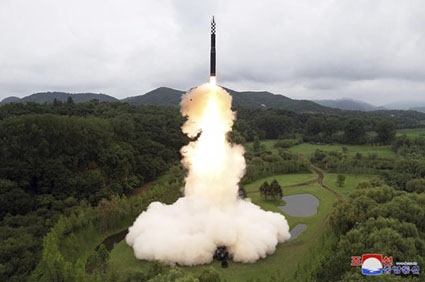Special to WorldTribune.com
 By John J. Metzler, July 18, 2023
By John J. Metzler, July 18, 2023
North Korea’s unannounced launch of another ballistic missile has nearly become a ho-hum event given the rash but predictable actions of Pyongyang’s rulers. After all we have seen this bellicose stunt many times before and thus have become dangerously numb and nearly indifferent to its ultimate threat and consequence.
Someday breaking news of such an action just may be followed by “This is NOT a Test!”
Kim Jong-Un’s secretive but isolated communist regime has few diplomatic cards to play except for military coercion and saber-rattling. But is anyone watching beyond Seoul, Tokyo and Washington, providing it’s not a weekend?
The quaintly titled Democratic People’s Republic of Korea (DPRK) deeply craves attention and political legitimacy; The DPRK communists have dramatically increased missile firings in 2022 and 2023 with more than 90 launches including those using ballistic missile technology.

The DPRK has launched 20 ballistic missiles in 2023, including four ICBMs.
The UN Secretary General strongly condemned the DPRK’s launch of another long-range ballistic missile; The Security Council went into session in an almost pro-forma reaction to yet again condemn North Korea’s moves which violate numerous resolutions on missile development, testing and nuclear proliferation. Curiously for the first time since 2017, the DPRK’s delegate attended the meeting.
Pyongyang’s political pyrotechnics of the lethal Hwasong-18 intercontinental ballistic missile and an impending nuclear test to possibly coincide with the 70th anniversary of the truce ending the Korean conflict in 1953, pose a series of political coercion moves by the Kim Jong-Un regime to regain the limelight and energize domestic mobilization with or without support from their comrades in Beijing.
Hwasong-18 represents a better and more lethal rocket. Using solid fuel, it’s more difficult to detect during its pre-launch activities and preparation. Thus, the warning time is cut among likely intended targets such as Japan and the United States.
The recent Hwasong-18 missile was launched from the Pyongyang region, with dictator Kim sitting gleefully in the audience, and reached an altitude of 6,648 km before falling into the sea. The flight was nearly 74 minutes, making it North Korea’s longest ballistic missile flight duration and capable of hitting the USA.
Speaking before the Security Council, U.S. Amb. Jeffrey DeLaurentis, deputy American UN representative stated bluntly; “Let us be clear about what this is: 20 tests of nuclear weapons delivery systems.” The Ambassador added, “As Council members, we all have the mandate and responsibility to confront the DPRK’s unlawful and unjustifiable development of ballistic missiles and weapons of mass destruction.”
Nevertheless any cooperation among the United States, France and the UK versus China and Russia towards solving the Korean crisis has been politically paralyzed for the past few years.
Addressing the Council, Khaled Khiari, Assistant Secretary-General, Department of Political and Peace building Affairs stated, “Key peace and security issues, such as the situation on the Korean Peninsula, must be an area for cooperation.” Mr. Khiari warned, “However, the lack of unity and action in the Security Council does little to slow the negative trajectory on the Korean Peninsula. The status quo is alarming and unsustainable.”
What’s prompting Pyongyang’s actions?
This may be part of the DPRK’s domestic political mobilization to strengthen Kim Jong-Un’s rule to counter his powerful sister Kim Yo-Jong poised behind the crimson curtain.
Equally there’s a hint in the numerology; the Korean War never officially ended but ceased with a truce signed on July 27, 1953. That significant 70th anniversary is fast approaching. Pyongyang’s intimidation measures pose a crude but effective way to try to possibly restart some sort of dialogue between the DPRK “Hermit kingdom” and the U.S. and South Korea.
|
North Korea fails to issue airspace warnings for its launches . . . .[which] pose serious risk to civil aviation and maritime traffic. |
So, what should we realistically do given the Council’s deadlock?
First, initiate a regional air traffic monitoring zone through the International Civil Aviation Organization (ICAO) and regional ADIZ’s of South Korea, Japan, Australia and the Philippines to be briefed with timely warnings of impending DPRK missile tests. North Korea fails to issue airspace warnings for its launches which could tragically lead to an unintended but inevitable civilian airliner being mistakenly hit. These unannounced launches pose serious risk to civil aviation and maritime traffic.
Secondly, renew negotiations between the U.S. and DPRK for the long sought formal Peace Treaty ending the Korean conflict, which were being explored in 2017, but in exchange for a moratorium on missile firings/nuclear tests by Pyongyang’s regime.
Just a positive note during the same week; democratic India fired an unmanned rocket on a scientific mission towards the Moon.
John J. Metzler is a United Nations correspondent covering diplomatic and defense issues. He is the author of Divided Dynamism the Diplomacy of Separated Nations: Germany, Korea, China (2014). [See pre-2011 Archives]
